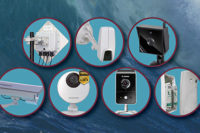Although the idea of incorporating video and audio capabilities in intrusion alarms is not necessarily a new trend, it is quickly catching on as a popular added benefit for customers — and the general population on whole.
Although these technologies have come a long way in 50 years, they have much humbler beginnings. The impact audio detection feature was originally pioneered by Sonitrol in 1964 as a response to a growing false alarm problem. Founded by an inventor and former chief of police, Sonitrol’s audio detection was born from a desire to meet two goals: to apprehend burglars and, in doing so, reduce the number of false alarms in the pursuit of this. The company began with 8,000 audio detection units, but since then has increased this number exponentially. Perceiving the effectiveness of this technology, other companies followed suit and developed similar technologies. Collectively, the results have been astounding: Sonitrol’s audio detection and verification technology alone is responsible for 171,433 arrests since 1977.
Audio detection has evolved over time, and alarm panels now incorporate a visual aspect with the aid of cameras designed to record video as well as sound and then transmit one or both of these media to an individual or central station. A review of the transmitted media allows for a quick determination of a break-in. Companies such as DMP and Bosch Security even have included a mobile aspect for homeowners, where upon break-in detection, recorded audio, video, and/or a still image is sent to a subscriber’s smartphone. By doing so these companies have put more control into the hands of the user, allowing for him/her to take action and verify the validity of the alarm.
For some, this is a strong sense of added security and has definite advantages. “We think that video verification should be done by the end user, not the central station. The end user is in the best position to verify if an alarm is real or false, and now with this technology we allow them to have all the information in the palm of their hand, so they can quickly make the decision,” says Mark Hillenburg, executive director of marketing with DMP.
Additionally, other manufacturers, such as Qolsys, are now incorporating cameras into panels. These cameras can then be used to take a photo of anyone who tries to deactivate or tamper with the system, offering further verification.
In addition to audio and video, two-way voice has become a popular feature to include in a system. In this way, operators at a central station can speak through the control panel, adding yet another dimension of verification to an alarm. A central station operator can speak directly to the current occupants of a building to ask something such as, “We’ve just received notification of an intrusion on the premises. We are in the process of dispatching local authorities.” In the event of an actual break-in, the burglar-to-be is likely to be scared off, thus minimizing further property damage and/or loss. If the alarm was triggered by accident or is otherwise false, a current occupant can then speak to the operator at the central station that there was not an actual break-in and can explain the circumstances of the falsely activated alarm. This feature also allows for a central station to dispatch emergency medical services in the event that one or more persons has been injured as a result of the attempted burglary and is in need of help.
Verified intrusion alarms allow police to take their dispatches more seriously, and therefore it stands to reason that they are quicker to respond when believing that an actual crime is occurring. Jeremy Bates, general manager, Sonitrol of Lexington and president of Sonitrol National Dealers Association, echoes this: “Audio and video verification provides a high level of confidence to law enforcement that their valuable time and resources are not being wasted as they know they are responding to credible alarm dispatches.”
Alarm Response Facts
|
As the industry grows with an increasing number of homeowners and business managers seeking security for their properties, so also has grown the number of false alarms. To ensure that the attention of the authorities be directed to the actual and true alarms, it has become increasingly important that alarms be verified through one of — or a combination of — the above mentioned methods.
The law enforcement community should not be the only one grateful for this technology; end users see the benefits of alarm verification, as well. With image and audio relaying to end users’ smart devices, end users gain a greater sense of comfort and control knowing who and when their secure space is being accessed, perhaps without their knowledge.
“With the proliferation of false alarms in the security industry, audio and video verification systems have a relevant and important place in our industry,” Bates says. “It has always been an effective technology, and with the growing false alarm problem, it will only become more and more relevant,” he adds. Having come such a long way since audio-only detection and with the fast emergence of new technologies, one is left to wonder what will come next. One thing that is nearly certain is the continued inclusion of mobile devices (and perhaps wearable technology as well, such as the Apple Watch) now in play. Tom Mechler, product marketing manager of Bosch, agrees: “We expect the demand for video verification to continue to grow along with the use of mobile devices. The technology is here. It is reliable, and customers expect this type of capability.”
The Ears & Eyes of Alarm Verification
In the image carousel above is a small collection of products from various manufacturers that are making use of one or more verification technologies. Whether on premise or on-the-go, these products are making alarm verification just that much easier.








